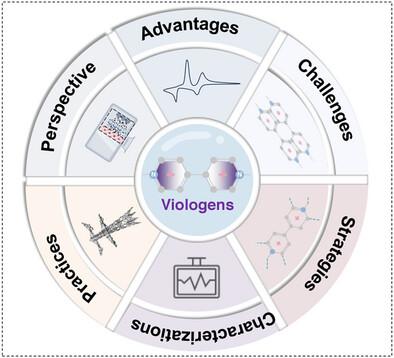Viologen Derivatives in Aqueous Organic Redox Flow Batteries: Progress and Perspectives
IF 26.8
1区 材料科学
Q1 CHEMISTRY, MULTIDISCIPLINARY
引用次数: 0
Abstract
Aqueous organic redox flow batteries (AORFBs) are attracting increasing attention as intrinsically safe and scalable solutions for grid-level energy storage. Among various organic anolytes, viologens stand out for their tunable structures, two-electron redox behavior, and cost-effective synthesis from abundant precursors. This review comprehensively summarizes recent progress in viologen-based AORFBs, highlighting their core advantages and central role in defining system performance. The major challenges that currently limit practical application are critically analyzed, including molecular permeation, radical cation aggregation, two-electron transfer limitations, and alkalization-induced degradation. Strategies designed to address these limitations are then discussed, such as bipolar molecule design, conjugation extension, steric and size engineering, complexation, and substituent modification, emphasizing how tailored structural features can synergistically improve anolyte stability, solubility, and electrochemical performance. Furthermore, complementary in situ and ex situ characterization techniques have deepened understanding of redox mechanisms, degradation pathways, and aggregation states under operational conditions. Looking ahead, advancing viologen-based AORFBs will rely on designing stable, high-concentration electrolytes, achieving efficient two-electron cycling, and integrating artificial intelligence-guided molecular design to accelerate discovery. Together, these efforts aim to enable durable, high-energy-density systems and bridge the gap between laboratory research and commercial application.

有机水氧化还原液流电池中的紫素衍生物:进展与展望
水相有机氧化还原液流电池(aorfb)作为一种本质上安全且可扩展的电网级储能解决方案,越来越受到人们的关注。在各种有机电解质中,viologens以其可调谐的结构、双电子氧化还原行为和从丰富的前体合成的成本效益而脱颖而出。本文全面总结了基于violoogen的aorfb的最新进展,强调了它们的核心优势和在定义系统性能方面的核心作用。对目前限制实际应用的主要挑战进行了批判性分析,包括分子渗透、自由基阳离子聚集、双电子转移限制和碱化诱导降解。然后讨论了旨在解决这些限制的策略,如双极分子设计、共轭扩展、空间和尺寸工程、络合和取代基修饰,强调了定制的结构特征如何协同提高阳极电解质的稳定性、溶解度和电化学性能。此外,互补的原位和非原位表征技术加深了对氧化还原机制、降解途径和操作条件下聚集状态的理解。展望未来,推进基于violoogen的aorfb将依赖于设计稳定、高浓度的电解质,实现高效的双电子循环,并整合人工智能引导的分子设计来加速发现。总之,这些努力的目标是实现耐用、高能量密度的系统,并弥合实验室研究和商业应用之间的差距。
本文章由计算机程序翻译,如有差异,请以英文原文为准。
求助全文
约1分钟内获得全文
求助全文
来源期刊

Advanced Materials
工程技术-材料科学:综合
CiteScore
43.00
自引率
4.10%
发文量
2182
审稿时长
2 months
期刊介绍:
Advanced Materials, one of the world's most prestigious journals and the foundation of the Advanced portfolio, is the home of choice for best-in-class materials science for more than 30 years. Following this fast-growing and interdisciplinary field, we are considering and publishing the most important discoveries on any and all materials from materials scientists, chemists, physicists, engineers as well as health and life scientists and bringing you the latest results and trends in modern materials-related research every week.
 求助内容:
求助内容: 应助结果提醒方式:
应助结果提醒方式:


